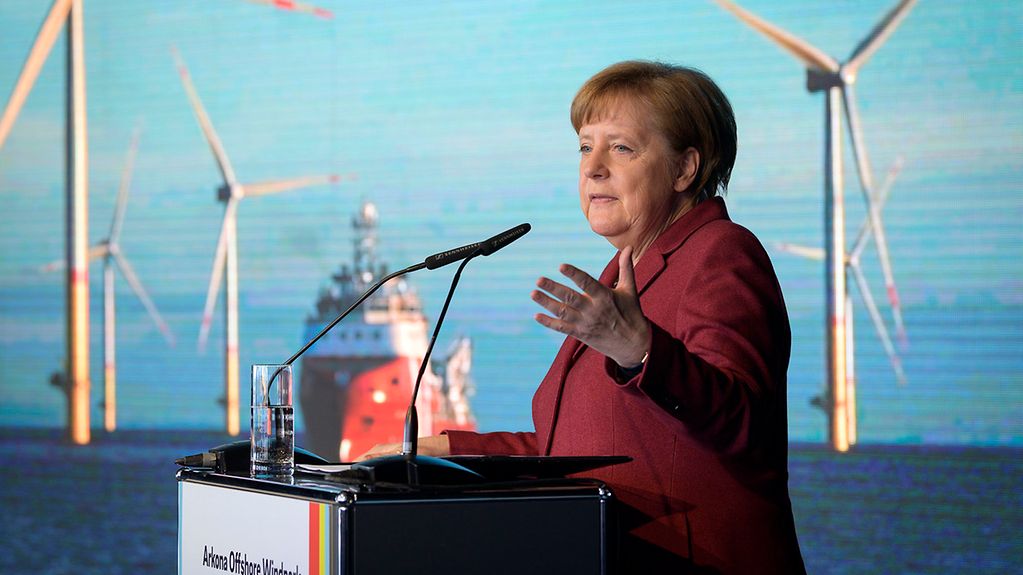Energy transition
35 kilometres north-east of the island of Rügen stands the largest offshore wind farm off Germany’s Baltic Sea coast. "Arkona sets new standards," said Chancellor Angela Merkel at the official opening ceremony. The wind farm has an installed capacity of 385 megawatts – enough to power 400,000 households.
4 min reading time

Chancellor Angela Merkel opens the Arkona offshore wind farm
Photo: Bundesregierung/Bergmann
In her address, Chancellor Angela Merkel said that renewables have shrugged off their niche existence and now stand centre stage in matters of energy supply.
The Chancellor called for greater speed in building the power transmission lines from the German coast to the south of the country. This, she stressed, is essential, for the intended promotion of renewable energy. Angela Merkel also suggested that more power could be used industrially in northern Germany, in view of the lack of progress on building transmission lines. There is no reason why technologies like cloud computer centres and IT servers cannot be established at the coast, she pointed out.
Higher than Cologne Cathedral
The Arkona offshore wind farm is a joint venture of the Norwegian shareholder Equinor and the German shareholder E.ON. It is 35 kilometres north-east of the island of Rügen, half way between Rügen and the island of Bornholm. The optimum wind harvest is assured with turbines built across an area of 39 square kilometres of sea.
E.ON and Equinor have shared the investment costs of some 1.2 billion euros. About 70 per cent of this sum was spent on contracts placed in Germany, according to E.ON. In recent months 60 wind turbines have been erected, with a hub height of a good 100 metres.
The rotors have a diameter of 154 metres, giving a total height of about 175 metres. The turbines consist of a 100 metres high tower, three rotor blades and the turbine unit. The tip of the rotor blades thus stands about 30 metres higher than Cologne Cathedral. The wind turbines are built at a water depth of more than 35 metres on steel foundations produced by a Rostock-based company.
Transformer station delivered by ship
The grid connection was the responsibility of 50Hertz, a subsidiary of the Belgian electricity transmission system operator Elia, which operates transmission grids in northern and eastern Germany. The offshore transformer station, the heart of the wind farm, comes from France. It weighs 5,000 tonnes and was supplied by STX Europe from St. Nazaire – 2,500 kilometres by sea.
Wind farms help save CO2 emissions
Wind farms at sea do not emit any climate-damaging gases. The Arkona wind farm alone will save 1.2 million tonnes of carbon dioxide emissions every year. One disadvantage of offshore plants, however, is that they only operate at maximum capacity for about half the total number of hours in a year.
Chancellor Angela Merkel pointed out that not only the power generation sector, but also the transport and building sectors will have to do their bit to achieve a 55 per cent reduction in CO2 emissions by 2030, as compared to the 1990 levels.
Wind power – a success story
In 2010, the Alpha Ventus pioneer wind farm, 45 kilometres north of the island of Borkum went online. In both technical and economic terms, wind power has since become a success story. Almost two dozen wind farms have been built in only ten years. More than 22 offshore plants today harvest wind in the North Sea and the Baltic Sea with 1,300 wind turbines and a total installed capacity of 6.4 GW. That is equivalent to the output of about six or seven large nuclear or coal-fired power plants.
The wind farms and the individual turbines are not only becoming larger and increasingly efficient. They are also becoming more and more economical. Alpha Ventus began with 12 five-megawatt turbines. Today, eight-megawatt models are available and ten-megawatt models are within sight.
Last year the offshore wind farms generated some 19 terrawatt hours of electricity. This year, the output is expected to be higher. The wind farms are reliable. Output is predictable. The rotors turn 363 days a year and operate at full capacity 4,500 hours a year. That is almost double the output of onshore wind power plants. Almost one fifth of Germany’s total wind power is thus probably generated at sea.
Ministers from Norway and France attended
The official opening of the Arkona wind farm was also attended by the state premier of Mecklenburg-Western Pomerania, Manuela Schwesig, Norway’s Energy Minister, Kjell-Børge Freiberg, France’s Minister for the Environment and Energy, François de Rugy, and the CEOs of E.ON (Johannes Teyssen), Equinor (Jon Erik Reinhardsen) and 50Hertz (Christiaan Peeters).